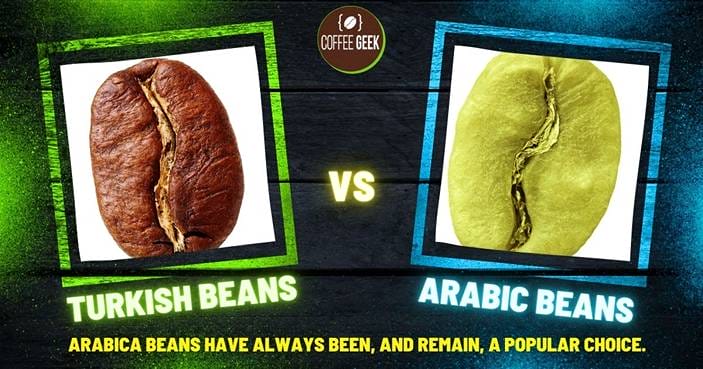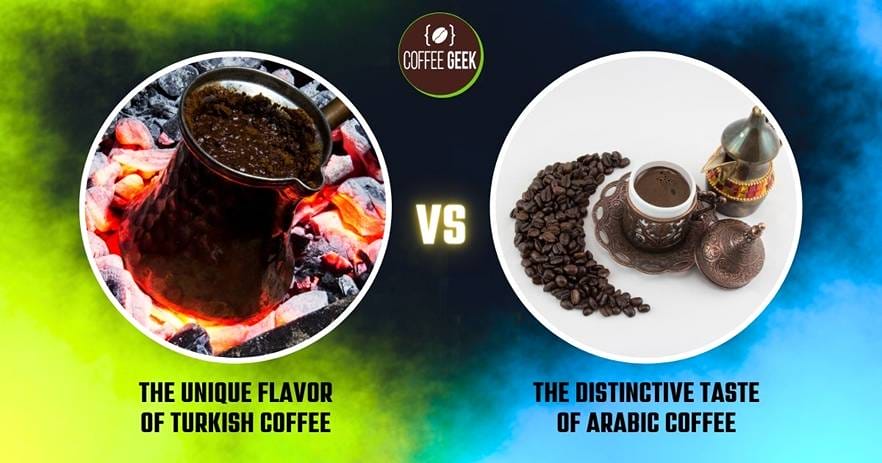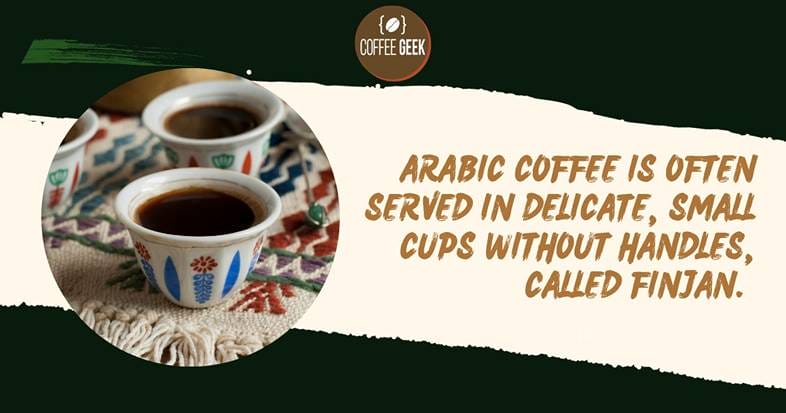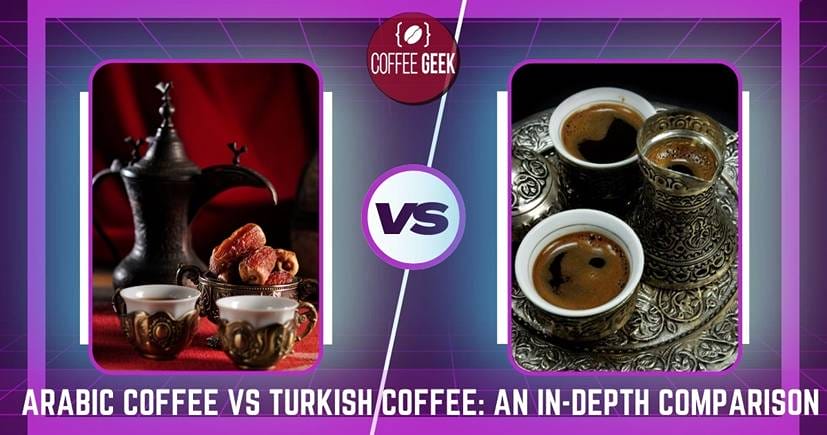The wonderful world of coffee is as varied and diverse as the countries that produce it.
In this in-depth comparison of Arabic coffee vs Turkish coffee, we will uncover the unique differences and similarities between these two beloved brews.
But before we dive into the finer details, let’s take a brief historical detour to understand their rich and flavourful origins.
Introduction to Turkish and Arabic Coffee
Brief History and Origin of Turkish Coffee
Turkish coffee has a long, illustrious history that dates back to the 15th century.
It became an integral part of the Turkish culture, with the process of brewing this coffee being given great emphasis.
The coffee is brewed in a special small pot called a cezve, which is a key component to achieving its signature taste.

Brief History and Origin of Arabic Coffee
Arabic coffee, also referred to as Arabian coffee, has roots that stretch back centuries. Arabic coffee is typically made from finely ground coffee beans, primarily from the Arabica coffee variety.
The many rituals surrounding both the preparation and consumption of Arabic coffee are a testament to the importance of this beverage within Arabian social and cultural life.
Understanding the Coffee: Turkish vs Arabic Beans
Popular Varieties of Turkish Coffee Beans
Turkish coffee ground often comes from a specific type of coffee bean.
There is no single type of bean reserved for Turkish coffee; however, Arabica beans have always been, and remain, a popular choice.
These beans offer a smoother, more rounded flavor when compared to other varieties.

Popular Varieties of Arabic Coffee Beans
Arabic coffee is often made from lightly roast coffee beans, Arabica being the most dominantly used variety due to its excellent aroma and flavor profile.
The roast is so light that the beans remain green in color, producing a coffee that is less bitter and more herbal and fresh in taste.
Distinguishing the Aroma and Flavor
The Unique Flavor of Turkish Coffee
Like Turkish coffee is known for its rich, potent flavor profile. It is made from finely ground coffee beans that are simmered (not boiled) in a pot, along with water and sugar, if desired.
Most people who’ve had Turkish coffee describe it as having a bold, strong aroma with an intense flavor that leaves a lasting impression on the palate.

The Distinctive Taste of Arabic Coffee
Arabic coffee is favored for its complex, aromatic, and subtly spiced flavor. Unlike Turkish coffee, Arabic coffee is usually made with lightly roasted beans and commonly flavored with cardamom.
Some variations may include other spices such as cloves. The coffee is often served in small cups for guests to enjoy at their leisure.
Brewing Methods of Turkish and Arabic Coffee
How to Brew Turkish Coffee

A traditional Turkish coffee brew begins with finely ground coffee beans, typically using an extra-fine grind setting. It is then carefully brewed in a cezve or coffee pot with water.
Sugar is added at the start of the process, as it won’t dissolve properly in the coffee once the cezve has been taken off the heat source.
How to Prepare Arabic Coffee

Arabic coffee is often prepared in a pot called a Dallah, giving it its distinctive flavor. The water and coffee are combined and allowed to simmer, together with cardamom, and occasionally saffron or cloves.
Following this, the coffee is then decanted and poured into small cups just below the rim.
Appearance and Serving Styles
Visual Manifestation of Turkish Coffee

The visual manifestation of Turkish coffee is quite distinct. Turkish coffee is usually served in a small cup, just like an espresso.
The thick layer of coffee grounds at the bottom of the cup, untouched by sugar or milk, is a striking characteristic of meticulously brewed Turkish coffee.
Presentation and Serving Style of Arabic Coffee
Arabic coffee is often served in delicate, small cups without handles, called Finjan. The coffee grounds are traditionally served in small cups and the coffee is usually drunk alone, without any form of cream or sugar.
It’s a ritualistic experience, often enjoyed slowly with family or guests.

Deciphering the Preference: Arabic vs Turkish Coffee
What Makes Turkish Coffee Special?
Turkish coffee is special for its bold, robust flavor and finely ground coffee beans. The tradition and culture that revolve around the making and consuming of Turkish coffee make it an experience, rather than just a beverage.
Why Choose Arabic Coffee?
Arabic coffee is a rich blend of tradition, culture, and craftsmanship.
Its unique brewing process, use of aromatic spices, and ritualistic serving style differentiates it from other coffee varieties and provides a drinking experience that is deeply rooted in Arabian culture.
| Aspect | Arabic Coffee | Turkish Coffee |
|---|---|---|
| Origin | Arabian Peninsula | Ottoman Empire, Middle East |
| Preparation | Simple | Elaborate |
| Coffee Beans | Light to medium roast | Finely ground |
| Roasting | Light to medium roast | Medium to dark roast |
| Grind Size | Coarse | Extra-fine |
| Brewing Method | Boiled or steeped | Boiled |
| Coffee Pot | Dallah or finjan | Cezve or ibrik |
| Ingredients | Coffee, cardamom | Coffee, water, sugar (optional) |
| Serving Size | Small cups | Small cups |
| Serving Style | Sips from a small cup | Sips from a small cup |
| Flavors | Cardamom, sometimes cloves | Rich, bold, and aromatic |
| Sugar | Rarely used | Optional, can be sweetened |
| Presentation | Plain or with dates | Often served with a glass of water |
| Traditions | Hospitality symbol | Social tradition |
| Enjoyment Rituals | Three sips | Fortune telling using coffee grounds |
| Cultural Significance | Arabian hospitality | Turkish coffeehouses |
Final Verdict: Arabic Coffee vs Turkish Coffee
Personal Preference and Enjoyment
The preference between Turkish and Arabic coffee ultimately boils down to personal taste.
Lovers of strong, robust flavors would appreciate Turkish coffee, while those who prefer a lighter, more aromatic beverage would gravitate to Arabic coffee.
Conclusion: Which Coffee Suits Your Taste
Arabic coffee vs Turkish coffee: it’s not a contest, but a celebration of diversity in the world of coffee.
Whether it’s the potent brew of Turkish coffee or the flavorful delicacy of Arabic coffee, each provides a unique coffee experience that reflects its cultural roots.
Arabic coffee and Turkish coffee are both esteemed in their respective cultures and have rich histories tied to tradition and hospitality.
One of the main differences between Arabic and Turkish coffee is the method of preparation and the flavor profile.
Turkish coffee that is brewed using a special coffee pot called a cezve. The coffee mixture consists of water and coffee powder.
The process involves boiling the coffee in the cezve until a thick layer of foam forms on top. It’s crucial to be careful not to let the coffee come to a full boil, as this could ruin the desired consistency.

The result is a strong, rich brew, and the foam on top is a significant characteristic. To serve, you pour the coffee into small cups, ensuring that the foam is evenly distributed.
On the other hand, Arabic coffee is also, like Saudi coffee, is also brewed differently.
The beans are roasted to a lighter degree compared to Turkish coffee. Arabic coffee that is traditionally served without sugar but might include the use of spices like cardamom.
When the coffee is ready, a layer of foam forms on top, which is carefully preserved when you pour the coffee to guests. This foam is considered a sign of a well-made cup.

Both types of coffee are deep-rooted in their cultures as a symbol of hospitality. Offering coffee to guests, whether it’s Turkish or Arabic, is a sign of hospitality and respect.
In many gatherings or events in the Middle East, the act of coffee being served and the ceremony surrounding it is a testament to its importance.
In conclusion, while both Arabic and Turkish coffee share similarities in the sense of hospitality, their preparation, flavor, and cultural significance distinctively set them apart.
FAQ
How does Arabic and Turkish coffee differ?
There are a few key differences between Arabic and Turkish coffee. Arabic coffee is typically served without sugar and has a unique flavor, often spiced with cardamom.
However, Turkish coffee is made with one heaping teaspoon of coffee powder and sugar, brewed in a special coffee pot called a ‘cezve’.
The resulting coffee has a strong, sweet and foamy texture. The key in both types is to cook the coffee slowly over low heat to help create a flavorful coffee.
What is the main aspect of making Arabic coffee?
The coffee is one made by grinding the coffee beans very thinly, simmering in a special pot called a dallah. The coffee is then left to settle, allowing the coffee powder to settle at the bottom.
The coffee is typically served from the dallah into a small coffee cup, usually without foam.
What is the special coffee pot called that Turkish coffee is made in?
Turkish coffee is brewed in a special pot called a ‘cezve’. This small pot has a long handle and narrow neck, perfect for slowly simmering coffee over low heat which intensifies the flavor.
Is the coffee made using boiling water?
In both Turkish and Arabic coffee, room temperature or lukewarm water is used initially with the coffee powder.
The mixture is then heated gradually over a low heat until it begins to froth but not boil, which would disrupt the layer of foam that characterizes the Turkish coffee.
How is the foam on the Turkish coffee created?
The layer of foam on Turkish coffee is created by brewing the coffee slowly over low heat in a special pot called a cezve. By not stirring the coffee and allowing the mixture to heat slowly, foam starts to form.
When it’s just about to boil, you remove it from the heat and pour a little into each cup.
The remainder is returned to the heat until a second foam forms and this is then used to top up each cup, thus maximizing the amount of foam in each serving.
Can you drink the coffee powder that settle at the bottom?
In both Turkish or Arabic coffee, the coffee powder that settles at the bottom of the cup is not typically consumed.
It is quite thick and sludgy, and doesn’t have a pleasant texture. So, enjoy the coffee before you get to the bottom of the cup!
Are there any traditions related to drinking Turkish or Arabic coffee?
Yes, there are traditions associated with both. In Arabic culture, coffee is also a gesture of hospitality, often served to guests in small cups. It’s common to serve some kind of sweet treat with the coffee.
Turkish coffee is traditionally served after meals and it’s common to read fortunes from the leftover coffee grounds in the cup.
Is there a difference in the grinding process between Arabic and Turkish coffee?
Yes, there is. For both types of coffee, the beans are ground to a very fine powder. However, Turkish coffee requires an almost powdery consistency, much finer than even espresso.
Arabic coffee can be slightly coarser, but it’s still finer than what you’d use for a standard drip coffee machine.
Is it common for sugar to be added to Arabic or Turkish coffee?
It’s common to add sugar to Turkish coffee. Usually, the sugar is added during the brewing process along with the coffee powder before heating.
However, Arabic coffee is typically served without sugar, but it can sometimes be flavored with spices like cardamom or saffron for a slightly sweet flavor.
What’s similar between Arabic and Turkish coffee?
The main similarity is the method of brewing. Both arabic and turkish coffee are brewed in a special pot and both require brewing over low heat.
Also, the coffee beans for both types are ground to a very fine powder. It’s these similarities that give both types of coffee a strong, rich flavor that’s loved by many.

